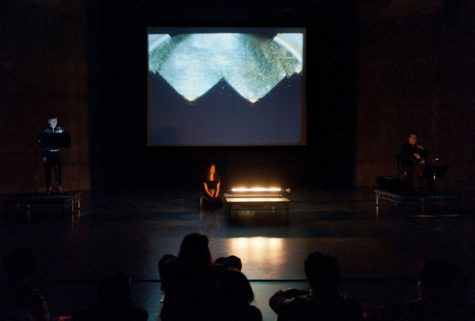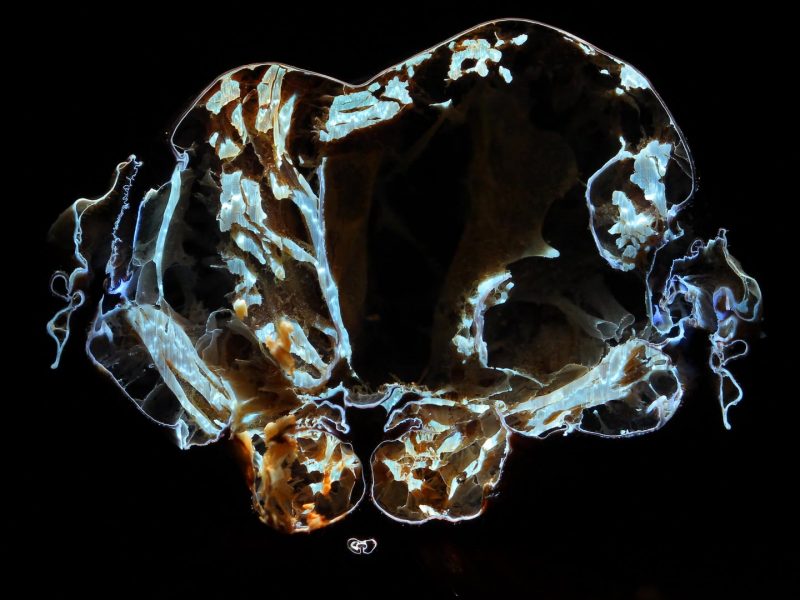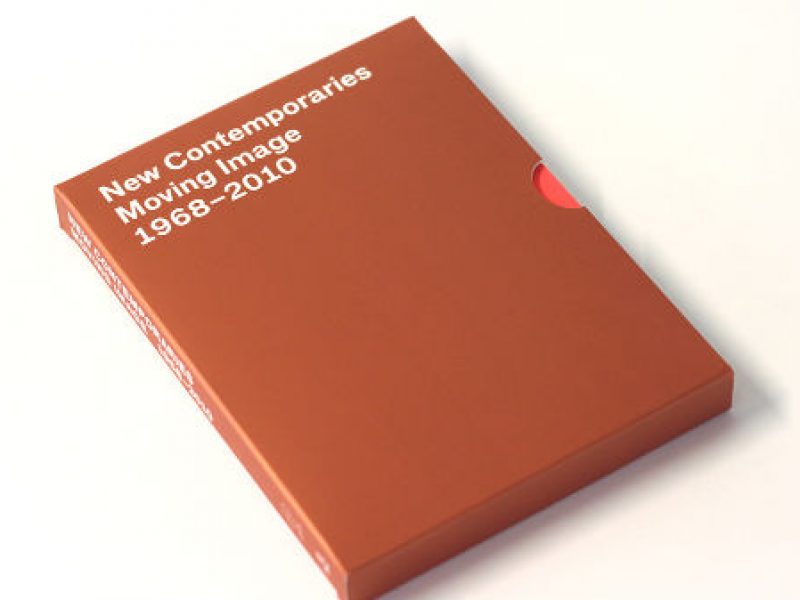Aura Satz explores voice and language through video, sound, installation and performance. Grounded in the psychoacoustic experience of the perceptual field, she approaches sonic form through deep listening and a dialogue-based compositional approach to amplify subtle experiences of reality. Satz’s films propose recalibration as a necessary and constantly shifting framework for modulating sensitive experiences, recalcitrant worlds of acoustic biases and hierarchies, and the conditions of now, extending the possibilities of listening beyond the non-auditory, the haptic, and the non-human.
Some of the oldest uses of the word ‘voice’ invest spoken languages with the value of a positive and self-authenticating truth. Voice is understood not as a condition of phonating, but as the foundational movement by which allegorical ideas become present in a field of shared listening. This forms the founding gesture of acoustic study and a philosophical tradition that inscribes meaning through sonic form. Related to the western philosophical affinity for abstract sense-making, knowledge and epistemology, this inaugural act of metaphysics separates speech from speakers, associating voice and address to its semantic value rather than its phonic substance.
Acknowledging that violence and violations take place on lived and representational registers, Aura Satz’s moving image works are concerned with fine-tuning the thresholds for listening and articulating a critique of metaphysical language. Sound and film drive each other to reveal spaces of deeper attention, an ethical programme that celebrates the sonorous materiality of voice and the gift of conversation. Folding multiple timeframes, forms of time that overlap, recede and renew across historic registers, voice emerges as a relational concept that calls for a shift from representation to expression. Because speech is sonorous, because it vibrates across registers of frequency, Satz’s practice destabilises the rational bond between voice and speech revealing the unheard background of relationality.
Satz’s sonorous images tap into a mode of address that is attuned to intergenerational conversations, with collaboration and citation taking a central part in her practice. She is inspired by women who create distribution circuits for making other voices audible and visible, chiefly those of women filmmakers, scientists, and composers that have been written out of the archive. Inspired by Circle’s inaugural film programme ‘Her Image Fades as her Voice Rises’ (1982), organised by Lis Rhodes and Felicity Sparrow, which brought together women filmmakers of different generations in dialogue with each other, this line of inquiry manifests a lucid awareness of auditory positionality.

In and Out of Synch performed at The Tanks, Tate Modern. Photo: Gabrielle Fonseca Johnson/Tate Photography, 2012, copyright Tate Photography
Some of these works dwell inside the score, in the compositional mind, and in a form of a listening that intentionally does not prescribe experience. Revealed in the style of portraiture, the films honour experimental women composers whose lives’ work aspired to heighten sensory perception: Oramics, Atlantis Anew (2011) is a short film about the British pioneer of electronic music and co-founder of the BBC Radiophonic workshop, Daphne Oram; Little Doorways to Paths not Yet Taken (2016) reveals a candid conversation with the American electronic music and algorithmic composer, Laurie Spiegel; and Making a Diagonal with Music (2019) is a spirited dialogue with the Argentinian electroacoustic composer, Beatriz Ferreyra. In Dial Tone Drone (2014), Satz uses the dial tone of telephones, transmission and electronic sound signals as a starting point for a composed conversation with Pauline Oliveros and Spiegel about drones and their use in music. Another composed telephone sound composition with French electronic music composer Éliane Radigue, Tone Transmissions (2020), pursues this line of inquiry through sonic register.
In another body of durational research Satz probes the cinematic image as one of the sites in which opaque technologies of sonic obedience and ideologies of rhythm are implemented. Sound Seam (2010) explores the enfleshed body as potentially inscribed with unheard voices or echoes from the past. The film uses microscopic photography, scanning electron microscopy, and sounds of otoacoustic emissions to explore ideas of encryption and decoding. In another work, scripted and voiced with Rhodes, In and Out of Synch (2012), abstract patterns of optical sound are encoded as light, brought from the soundtrack area of a filmstrip to the main frame of the image. Alongside The Trembling Line (2015), a film and sound installation exploring acoustics, vibration, sound visualisation and musical gesture, these projects highlight the intersections between art, film, installation and the live event present in Satz’s practice: from works that circulate as single-channel screenings in film festivals to expanded iterations of the same projects, involving complex sound and film environments presented at galleries and museums.

The Trembling Line installation view, John Hansard Gallery, 2015. © John Hansard Gallery. Photograph: Steve Shrimpton.
Another film installation, Chromatic Aberration (2014) looks at the early technologies of colour filmmaking revealing a concerned interest with how cinematic images have changed, adapted, and globalised in the political geometry of contemporary capitalism. In Doorway for Natalie Kalmus (2013), minute shifts across an abstract colour spectrum are punctuated by a mechanical soundtrack based on the ‘colour scores’ invented by Natalie Kalmus, the former spouse of technicolour inventor Herbert Kalmus. Testing the perceptual mechanics of visual interpolation, Between the Bullet and the Hole (2015) explores the flickering space between intercalated frames of bullet sound wave imagery and forensic ballistic photography. The latter explores women’s role in ballistic research and early computing and reveals another thread of the artist’s research into sound control and predictive surveillance technology.
Entangled nightvisions (2017) looks at the history of the development of image making technologies from the perspective of night vision, redrafting its history through metamathematics, matter and energy present in the work of experimental philosopher and poet, Johnny Golding. And the first instalment of a larger body of research, Preemptive Listening (Part 1: The Fork in the Road) (2018), posits the siren’s glissando as a sonic signal that can potentially be perceptually and musically rewired. Composed with Lebanese trumpet improviser Mazen Kerbaj and actor and activist Khalid Abdalla, its soundtrack activates a set of emergency rotating lights that compose the film’s visual narrative. Attentive to acoustic developments in contemporary warfare, this body of work speculates on how sonic frequencies redefine spaces of conflict.
What emerges in these expanded constellations of sound and film – both formally and as subject matter – warps the space between the aural and the cinematic, opening up new sonic possibilities for immersive listening. Revealing themselves in the presence of the mechanics of making, these films are a mode of feminist address that make legible uneven forms of metaphysical language. Instead, Satz proposes feminist ideas of diffraction and vibration to recalibrate the eye and ear of governance. The revelatory function of filmic and sonic languages in her work express the fundamentally relational condition that resounds in the register of voice. As the Italian philosopher Cavarero’s notes, ‘to speak to one another is to communicate oneself to others in the plurality of voices.’[1] Satz’s moving image works asks us to welcome these ideas acoustically, to be open and receptive to aural diversity, to forms of non-cochlear hearing, to the unheard, and the silenced. They are a powerful reminder of Pauline Oliveros’ maxim: ‘listen to everything all the time and remind yourself when you’re not listening’.[2]
[1] Adriana Cavarero, Toward a Philosophy of Vocal Expression, California: Stanford University Press, 2005. 13.
[2] Pauline Oliveros, ‘Quantum Listening’, 1999. 3. (online) https://soundartarchive.net/articles/Oliveros-1999-Quantum_listening.pdf
Sofia Lemos is a curator, writer, and researcher. She is Curator of Public Programmes and Research at Nottingham Contemporary and Associate Curator Public Programmes at the 2nd Riga International Biennial of Contemporary Art (RIBOCA 2). From 2017, she leads the multi-platform symposia series for visual and performing arts research METABOLIC RIFTS, with Alexandra Balona. Lemos is Associate Editor at The Contemporary Journal and is a regular contributor to Art Agenda and Lisbon-based Contemporanea. Her writings on contemporary art and culture have featured in publications such as Document Journal, MOUSSE, vdrome, …ment, and Volume, and in several catalogues and monographs.








